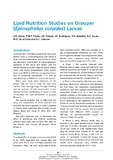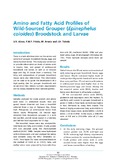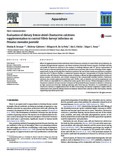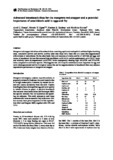Lipid nutrition studies on grouper (Epinephelus coioides) larvae
Share
Abstract
The main objectives of this project were to study the lipid chain transfer from the egg stage through hatching and the patterns of lipid conservation or loss during starvation and feeding of larvae in order to elucidate the lipid metabolism of grouper (Phase 1); to determine the fatty acid composition of highly unsaturated fatty acid (HUFA) boosters and enriched live food organisms to enable the possibility of choosing food organisms that provide various dietary levels and ratios of docosahexaenoic acid (DHA), eicosapentaenoic acid (EPA) and arachidonic acid (ARA, Phase 2); and to determine the effect of Brachionus and Artemia, containing different levels and ratios of DHA:EPA:ARA, on the growth and survival of grouper larvae (Phase 3). Total lipids (TL) of samples were extracted and separated into neutral (NL) and polar lipids (PL). The samples collected in Phase 1 were floating neurula eggs, newly hatched (NHL) and unfed 4-day larvae; larvae fed with live food organisms for 25 and 35 days or starved for 3 days; and wild-sourced larvae starved for a week. In Phase 2, the samples collected were phytoplanktons, Brachionus cultured in phytoplankton for 4 days, Diaphanosoma celebensis and Pseudodiaptomus annandalei. In phase 3, larvae were fed Brachionus until day 14 and at day 25 with Artemia. E. coioides eggs contained high DHA, EPA and ARA, demonstrating their importance in larval development. Larvae primarily spent NL as energy, whereas PL was generally conserved. Wild grouper larvae had higher levels of PL than NL, whereas hatchery-sourced eggs and larvae contained higher levels of NL than PL. Based on the lipid content of wild larvae, high phospholipid diets were essential for larvae survival and normal development. A variety of products were effective in enriching the HUFA content (particularly ratios of DHA, EPA and ARA) of live food organisms. HUFA-enriched live food organisms enhanced the growth, survival and pigmentation in grouper larvae.
Suggested Citation
Alava, V. R., Priolo, F. M. P., Toledo, J. D., Rodriguez Jr., J. C., Quinitio, G. F., Sa-an, A. C., … Caturao, R. D. (2004). Lipid nutrition studies on grouper (Epinephelus coioides) larvae. In M. A. Rimmer, S. McBride, & K. C. Williams (Eds.), Advances in grouper aquaculture (pp. 47–52). Canberra: Australian Centre for International Agricultural Research.
Subject
Collections
Related items
Showing items related by title, author, creator and subject.
-
Amino and fatty acid profiles of wild-sourced grouper (Epinephelus coioides) broodstock and larvae
Alava, Veronica R.; Priolo, Flora Mae P.; Toledo, Joebert D.; Rodriguez Jr., Jesus C.; Quinitio, Gerald F.; Sa-an, Analyn C.; de la Peña, Milagros R.; Caturao, Romeo D. (Australian Centre for International Agricultural Research, 2004)This study was undertaken to provide information on the levels of amino acids in the muscle, liver and gonad of wild-sourced broodstock and larvae, as well as in neurula eggs and day 35 larvae from a hatchery. The fatty ... -
Evaluation of dietary freeze-dried Chaetoceros calcitrans supplementation to control Vibrio harveyi infection on Penaeus monodon juvenile
Seraspe, Ebonia B.; Gabotero, Shirleny; de la Peña, Milagros R.; Pahila, Ida G.; Amar, Edgar (Elsevier, 2014)Effects of supplementation of diets with freeze-dried Chaetoceros calcitrans to control Vibrio harveyi infection are evaluated through immune responses, and disease resistance of juvenile Penaeus monodon. Total lipid and ... -
Advanced broodstock diets for the mangrove red snapper and a potential importance of arachidonic acid in eggs and fry
Emata, Arnil C.; Ogata, Hiroshi Y.; Garibay, Esteban S.; Furuita, Hirofumi (Springer Verlag, 2003)Mangrove red snapper fed advanced broodstock diets containing squid meal and squid oil exhibited higher hatching rates, cumulative survival and survival activity index than those fed a basal diet or a basal diet supplemented ...





